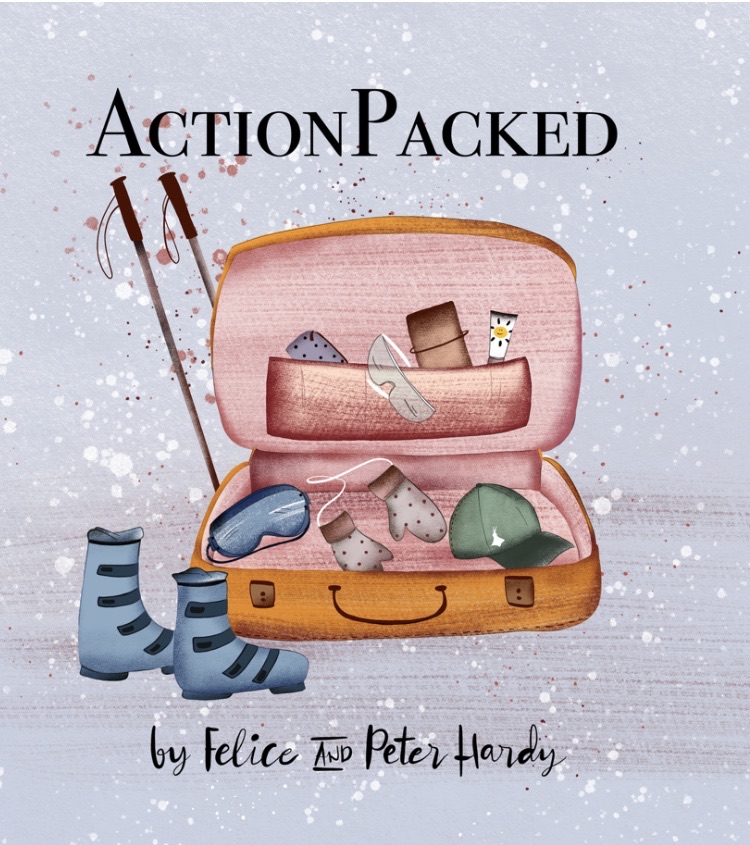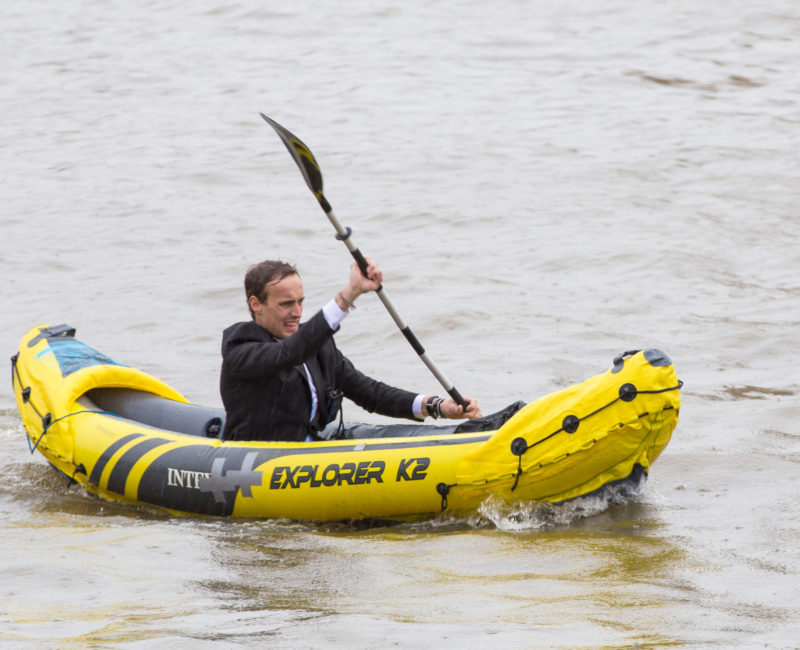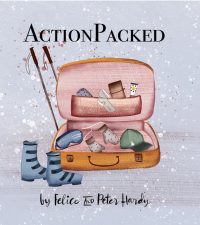
George believes the daily commute should be as fun as possible, which is why he paddles to work 10 miles down the River Thames. Photo: © Laura Dale / Caters News
This week, we’re entering, quite literally, into the spirit of adventure as seen through the eyes of explorer George Bullard, roving ambassador for his family’s gin company. Bullard’s has been brewing beer and distilling gin in Norfolk since early Victorian times. George is best described as a real-life action man. Ever since he was a schoolboy he’s swum, sailed, kayaked and walked across giant swathes of the planet in aid of scientific research or just plain adventure. Quite simply, George seeks to go higher, further, faster, longer than anyone else.
Felice Hi, George, welcome to our travel podcast. Lock-down must be particularly frustrating for someone like you – but people who are back in their London office, heeding government advice to avoid public transport, might like to follow your example and commute to work by kayak on the Thames.
George Good morning, guys. Thank you very much for having me on your podcast; it’s a pleasure to be here. So you’re right – I do kayak along the Thames. It all started a few years ago when I used to work in finance. I used to work in the City and I had to train for one of my expeditions, one of my adventures. So I bought a blow-up kayak and named it Kevin, paid eBay £70 for the pleasure of it. Every morning at about quarter to six I would pump up Kevin, much to my flatmate’s annoyance. I used to live in Battersea and I would paddle along the Thames into the City and I’d get out just beneath the Bank pub by Cannon Street tube station and walk through the City with Kevin on my head.
You can imagine some of the slightly strange looks I got, but it all made it worthwhile when just one person looked off one of the bridges as they walked on their commute into work. And it made them smile, that kind of made it all worthwhile. I guess it’s one of the main reasons why I decided to kayak to work – aside from training for an expedition. Really it was the fresh air that I got from the Thames, and it allowed me to avoid the rather less-than-fresh armpits and burping and farting that goes on in a tube carriage with 150 other people. So I though, why not? Let’s just do it.
Felice I wanted to ask you – if other people wanted to do the same thing, do they need a license? Do you need a license or do you just chuck the boat in and go?
George So you do need a license to do it. I spoke to the Port of London Authority just before doing it and said: ‘Look, you know, this is what I’m doing. I would like to do this. What do you think?’ And they were scratching their heads, like this has never, ever happened to us. And the person on the phone had to go away and talk someone else before they got back to me. And they asked me a whole lot of questions about my experience and things about qualifications which I have.
And eventually they were like: ‘You must wear a life jacket and keep out the way of traffic,’ both of which are reasonably obvious. And eventually I got it. But I have a few stories – of being chased by various police who maybe didn’t get the message that I was allowed to do this. And actually one morning paddling into work, I was up near the city…
Peter Are you wearing a suit this stage?
George Not quite, but beneath I had a dry suit on – so I can wear bits and bobs like my pants and things – you know, it’s pretty rank. And there was luckily a changing room at the office, so I could pack a waterproof bag with a clean shirt in. And because, you know, there’s some pretty unattractive things in the terms of diapers and lots of nappies and things that you come across.
And so I was padding into the office one morning. I know it’s so funny. Where did you get near the city or near the end of the river there’s quite a few bridges and quite a few pillars. And I could see the police waiting for me. They were 100% – I mean, their blue lights were all but on – on their boats. They have a boat that buzzes up and down the Thames. And I was about to collide with the police. The only reason they didn’t stop me was because they just couldn’t quite get close. I just darted through the pillars and the various bridge and obstacles – it meant I could just about skip to my landing point and get away. The next morning whether they got the message or not, it was certainly quite exciting for a couple of minutes as I was running from the police. I hasten to add, it was the first and last time I’ve ever run away from the police.
Peter So what started your interest in perpetually breaking records? This started when you were a little boy? Tell me about it.
George Yeah, I get asked this a lot. A lot of people have a life experience, an illness, or you know, a sudden experience which makes them realise just how to frail we all are on this planet. And that’s their reason. And I had a few of these things, I had a few bad things happen to me, which I may come on to soon. But most of that was on expeditions and adventure. So where I think my adventurous spirit has come from is actually my childhood. I think that we are all as children, curious. We all have a sense of wonderment, a sense of what’s around the corner, what’s up the tree or under the water. We’re all inquisitive and curious as to what lays around the corner. I just really think I’ve clung on to that childhood obsession with what might lay in the river or up the tree and that kind of leads me to continuously climb trees and stay adventurous. And obviously that’s procured into something on a rather large scale basis. But it’s something I love, that I’m incredibly passionate about.
I’ve seen the benefits that its had for children and adults alike. The idea of the National Health Service being called the Natural Health Service. There’s a lot of things that we’re experiencing as humans and that right now, a lot of conditions which we experience, which can be cured not by going to the National Health Service but by simply going outside. That idea of a natural health service is something which I really buy into, and the power of the outdoors being used to change lives. I totally buy into it.
Peter So what was the first big adventure for you? I think you swam across the Channel?
George I guess even as a young boy, I’d been doing a little adventure. But that really was the first big one that I did back in 2004 when I was just over 14, nearly 15 years old. That was really the first opportunity I had, alongside an amazing team of swimmers and also a very inspiring coach who gave us this opportunity to swim the channel. And obviously, there were a few of us in the team who weren’t so keen to do it. But equally, there was a significant proportion of the team who were like, you know ‘What, let’s go for it, what’s the worst that can happen? We could fail. That’s really the worst that can happen. You know, we’ve got a boat next door to us. We’re not going to drown, we’re not going to die doing this, so let’s give it a shot. See what we’re made of. What have we got to lose? What is it that we might come home regretting?’ For me, that regret would have been not trying.
Peter And when was the first big one?

Part of exploring the planet – a Greenland crevasse
George The first, really huge one that I did was in 2008, and I was nearly just 19. And I just given a talk at the RGS in London about going to Antarctica, trying to find a new species of fern, and to try and find Shackleton‘s stove on the island of South Georgia. And I came from that and this guy called Alex, who I’d never met before, came up to me and said: ‘Do you want to do this adventure with me? This adventure was the longest fully unsupported polar journey in history at the time.
And I scratched my head for about 10 seconds and thought, yeah, right, let’s give it a shot. Why not? What have I got to lose? I might fail, I might die, but we’re all going to die. That’s the conclusion I had drawn in those four years: that we’re all going to die at some point, so I might as well try. And that was the first time we met. The second time we met, we were packing our sledges. And the third time we met was in Stansted Airport. We flew to Iceland first and then from Iceland to Greenland. And yes, that was the third time we’d met.
So we then set off on a journey which is hard to put into words actually, even over the course of a podcast. But a journey which changed my life forever, without a shadow of a doubt or lying. We didn’t obviously have seats, we never saw the colour green. There was obviously no greenery, no green trees, things like that. And the only real proof that the world outside still existed were the planes flying over our heads as we walked for 113 days, just under one and a half thousand miles. It was without doubt something which I will obviously remember and cherish for the rest of my life.
It’s changed my perspectives on life. It’s changed the way that I look at a plate of food. It’s changed how appreciative I am of simple things like having a shower or putting on a clean set of clothes. I changed my underwear zero times. I changed my base layers once. I had the same pair of pants all the time because I thought they were lucky. And luckily I was still alive, so I think those pants are incredibly lucky. So if you want to borrow them, you can!
We ran out of food. There’s so many stories that we could we could dive into, so I’ll give you this one just to give you a feeling for the days and months that passed whilst I was there. All of my friends were taking time out in between school and university. I failed to get into read medicine at university, so I was forced to take a year out. And all my mates were off to amazing places travelling and working for charities and things. And there was me on an ice cap with one other bloke for four and a half months. At the time it was a slightly peculiar choice to make for a testosterone-fuelled young man, but I did.
And day 104, we laid food depots on our outbound journey that we were then feeding off on the way home. So we would hop between those food depots. And on day 104, Alex was on the GPS because we’d obviously marked those depots with a GPS coordinate – and also built a small cairn so that when we came back to it the GPS would bring us to the rough area. But the cairn would then be right underneath that. And we didn’t know whether the ice cap during such a long period of time over the summer months would decrease or increase in height, or how it changed. No one knew. So we decided we would bury our food depot about a foot under the surface of the ice, and then build a cairn as big as we possibly could manage. And we were hoping that it might lead us to the depot on the way back.
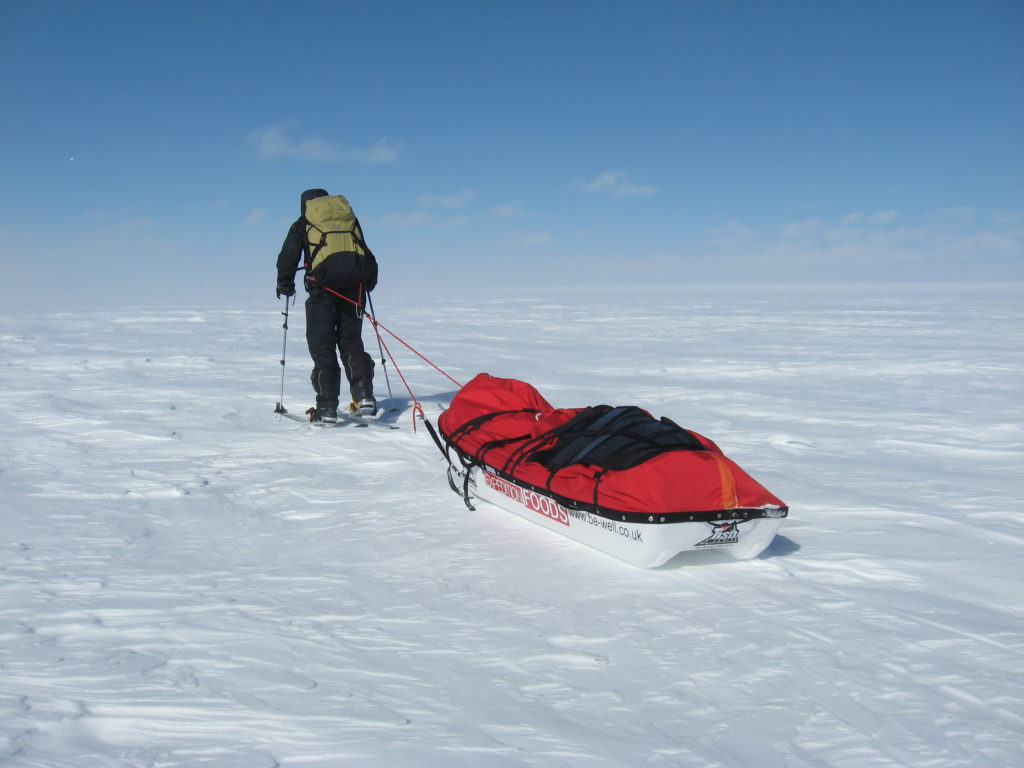
George hauling a 200kg sledge
Alex was on the GPS and we were homing in on our second to last depot, and he said: ‘Stop we’re there.’ And we both looked around us. And just to give you an idea of the gravity of the situation, we might not necessarily realise it in our day-to-day lives, but we need food to survive. That might sound obvious, but maybe coronavirus has taught us a little bit about what is really required to survive: food, water and warmth. And suddenly, we looked around us and couldn’t see any evidence of any food, any mark of any human ever having been there – no cairn, nothing but flat ice – and one of those key ingredients for life was torn away from us.
There really isn’t a word or a way to put that into words because there really isn’t a word that exists to describe it. Nut I guess either you could break down and cry, or you could take a deep breath and realise the challenge that you have ahead of you, realise the magnitude of what you needed to do – and press on. And, you know, that’s pretty much what we did. After about five minutes of probing with a tent pole to try and find something beneath the ice. It was a futile effort because let’s be honest, we could spend half a day trying to find it. We may or may not find it at the end of the day. And then, you know, we’re half a day’s food behind if we haven’t found it.
So we decided the time to scratch it, leave the food and go on. That was especially annoying for me, because that was the only depot where I had two massive treats on this expedition and they were a pack or two packs of Haribo Tangfastics – and your tastebuds to fresh food and sour explodes in that environment, especially when you haven’t had any of it. So that depot was one I was looking forward to beyond all belief. So not finding it was a massive blow. What I could do, I suppose, for you guys is I’m giving you the GPS coordinates if you’re desperate for Haribo Tangfastics you can go and take a look for it, it might still be there.
But we walked. We lived off butter, which had some pure fat left over. We had we survived off two and a half flapjacks a day, which we made into those sort of fat balls which you feed the birds in winter. We ate it like an apple, sitting on the front of our sledges during our breaks. Alex would have a bite of the apple, I would have a bite of the apple, and at lunch I’d have two bites and he would have two bites, and that saw us through to the last nine days of the project. So you can see now how these sorts of things start to change your perspectives.
Felice After that expedition, you went back to Greenland again and then you kayaked all the way to Scotland?
George In 1728 an Inuit man landed on the north east coast of Scotland and no one knows where he came from. I think he was bloody lost, to be honest, but three days later he died. And they believe that he came from Finnmark in northern Norway. Northeast Scotland, northern Norway, it’s a plausible journey for someone to be lost on at sea in the kayak. It’s plausible, but pretty extreme. Anyway, we went to look at his boat, which you can go to currently see in Aberdeen Maritime Museum and see his boat hanging up there.
And you can touch, you can see also the paddles that he was carrying and also the the weapons that he was carrying. Cute hunting. And we were also inspired by a book called Searching for Finn-Man, and that describes the ancient phenomenon of this Finn-man arriving on the northeast coast of Scotland. But his paddle and his hunting equipment and his kayak were all traditional Greenlandic styles. So we were like: hang on a minute – this guy did not come from Finnmark in northern Norway; he must have come from Greenland. Is that indeed possible? So the reason for the project was to honour this ancient myth. I guess to add fuel to the fire of speculation that he may well have paddled the entire way across the North Atlantic Ocean, which is a pretty extraordinary journey to make in 1728 in such a fragile craft.
The craft was made of whale bones and seal skin. Isn’t that phenomenal that those sort of things existed? And now we exist in carbon Kevlar and plastic and composites. You know, it’s a phenomenal feat of endurance. So that’s exactly what we said we’d do. We wanted to kayak all the way from Greenland back to Scotland. It was like a delicious island, hop, a Caribbean-style island, hot from Greenland ice, then ice into the Faroes, North Roe to Scotland. But sadly, without the sun and the white sand beaches.
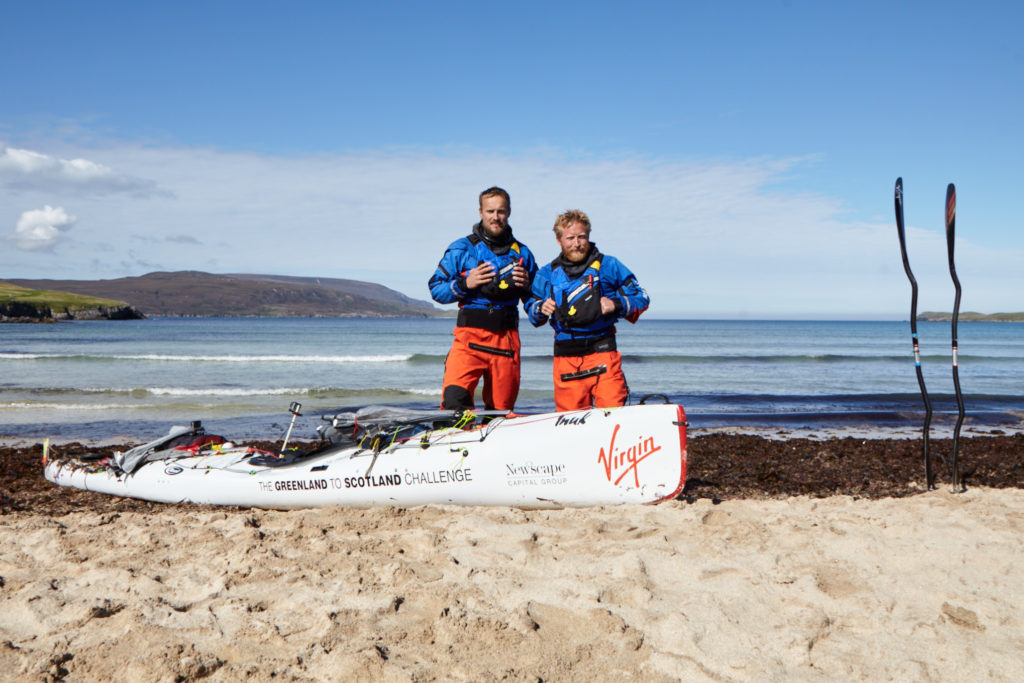
Kayak finish line Scotland. George pictured left. Photo: © Henry Hunt
Peter So how long did it take you to paddle all that way?
George So the journey from Greenland to Scotland in its entirety was 66 days. But of course there were lots of delays for weather, waiting for the right weather forecast. We were in a tiny 26-foot-long kayak. There was no protection from the elements really. We didn’t have a dry compartment onboard the boat. It was, in fact, more like a spirit than anything else. We slept down inside the boat, so we sort of shuffled ourselves down inside our cockpit and adopted the coffin position – we couldn’t roll over to sleep on our sides, can’t really stand up, walk around.
So it was it was a very traditional kayak that you’d see, I guess, on the TV, on the slalom races. That looked quite like that. That was two of us in it, one behind the other , it was a double kayak. And as a result of us being so vulnerable, we really had to make sure that when we touch land for the last time and headed for the ocean to cross another sort of vast patch of water between these islands, between Greenland’s ice and Iceland, the Faroe Islands to Scotland. We really had to make sure that we’re making the right decision because we really were putting ourselves in some pretty serious danger and there wasn’t a support boat with us at all.
Even though it was filmed by Red Bull, so you can go watch it right now and and see our misery unfold in front of you on the internet. Sleeping was a pretty interesting challenge, as was going to the loo. Actually going to loos is something people are interested in, especially when you’re on a kayak. Because you can’t put your put your bum over the side because you would fall out, or the boat would rotate and capsize.
So we went to the loo on a plate, we had to sit up in our cockpit, slide a plate underneath our bum and and do our business on this six-inch diameter plate with very small rims. And therein lies quite a few hazards, because your loo seat is also where you work, where you paddle. It’s also your pillow, where you sleep at night. So you had to make a mental note of how many kids you dropped off at school and made sure that they did get dropped off at school before before sitting down again – else you’d have a rather nasty surprise.
Felice I once kayaked round New York, around Manhattan.
George Oh, nice.
Felice And you swam it?
George Yes, we swam it the year we swam the channel. We went to swim around New York, so we started in South Cove and we went out round the East River with the current, into the Harlem River against the current, and then down the Hudson. But where did you go? It sounds so cool.
Felice It was about ten years ago, so I can’t remember exactly. It was a sunset tour. We went in a group of about eight kayaks – we had to stick together because there was quite a lot of other traffic in the water.
George Some big currents…
Felice Yes, and so we were told that all we had to sort of stick together – rather like fish stick together, so you look like one great big boat rather than lots of little ones.
George Absolutely. That makes a lot of sense.
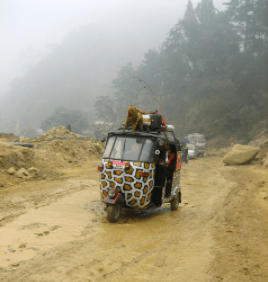
The tuk-tuk in India
Peter George, your eternal quest for adventure has taken you all over the world. You once drove a tuk-tuk across India?
George Yes, that was great fun. We were a group of 15 friends from university and I read about this challenge online and decided that…well, two of us decided…that we would motivate the troops enough to get them into a tuk-tuk. We had a motorised tuk-tuk, so it might not be the bicycle tuk-tuk that you were thinking of, maybe a rickshaw. I’m never quite sure of the difference. But we started in in Pockara in Nepal and rented these rickshaws, rented five rickshaws and drove all the way down to the southern tip of India in Cochin. And it was a truly fantastic adventure. I generally think that we probably drove through some places which, you know, very rarely see tourists and probably not very often see a white person. And so it was a real opportunity to see true India.
We stopped in at a few of the major sites, places like Varanasi and those sorts of places, which is steeped in history, and stopped obviously on the banks of the Ganges and saw bodies burning, bodies floating down the river, as is customary with their beliefs, their religious beliefs. That was a really extraordinary journey. And of course, being students, we were cutting costs every corner, every time we stopped for the night. And we never really booked anywhere, we’d just find somewhere that evening.
One evening, we came across a hotel where the only bedroom they had was the marital suite. And so 16 of us decided we would take this marital suite, for I think it added up to be one pence per person for the night. And we ended up all sleeping on a heart-shaped bed, which was very romantic.
By and large, we tried to tried to avoid the larger rates, which are kind of added to the adventure a little bit – added to the seclusion. I was led to believe that bigger roads in India are pretty dangerous, pretty nasty. I think that was where we had our only accident of the trip. One of the guys crashed – had a collision with a lorry, which sounds more concerning than it actually was. Everyone was fine, but there was still a rickshaw – a tiny vehicle – and a lorry – a massive vehicle – involved in the collision.
But everyone was okay. Actually, someone was held at gunpoint, that’s a good point. I forgot that one of the team stopped for some reason in a village and a sign offered a cup of tea by the locals and they said, yeah, we’d love to, that’s so kind. Thank you. And obviously maybe assumed – incorrectly – that the tea was a gesture of goodwill. I think it turned out to be something different. And so when we saw them that evening, they were totally pale, completely white and totally shell-shocked as they had to run away in their rikshaws from men with guns, asking them for some rupees to pay for their tea.
Felice Have you had any other dangerous experiences, near-death experiences, on your travels?
George Yes. I guess I have. Fortunately it didn’t happen to me directly, but I certainly had an experience which has changed me. In 2011, I was an adventure guide on an expedition where we took around 75 young people to Svalbard. It was about two weeks into the trip and everything was phenomenal. The anticipation, the excitement, had not worn off, it was still bubbling away – everyone’s having a fantastic adventure.
We were about two hours or maybe an hour helicopter ride, half a day’s boat ride really, away from from the main town of Longyearbyen at the base of the Von Postbreen glacier, which someone might know. We were camping there on the beaches and the purpose of the trip was all around youth development, scientific research and leadership skills for these kids who are all between the ages of 16 and 23.
Two weeks into the project, my particular team was just about to get really stuck into to a crossing of Svalbard and I happened to have the doctor in my group as well – or one of the doctors. And we found out at 7.30 on the Friday 6th of August, that a polar bear had attacked and killed one of our teammates. Fortunately, he wasn’t in my group, but our team when my leader team, I guess, was one of the first guys to arrive there that morning because we had the doctor in our group. So, you know, it was a pretty significant, such a pressing situation that we were then faced with, which certainly affected me very deeply. And initially, you believe that it’s your fault and that you should’ve done more to protect this guy from being attacked by a polar bear.
Anyway, the long and short of it really from a legal standpoint, is that it’s gone through lots of different inquests – public inquests and private inquest and it’s generally been put down to an accident. So I guess after a little bit therapy and chatting with people I’m more comfortable with the idea that I was guiding an expedition where a young man got killed by polar bear.
Peter Yes, these kind of dreadful experiences can change your life a bit, can’t they?
Felice So you do a lot of work with young people, sort of passing on your enthusiasm to them?
George Yes, it’s now really my mission to ‘rewild’ humans. It’s not just young people or anyone in particular really, just humans in general I think have become incredibly disconnected with our planet. To such an extent, that now a treatment for mental illnesses or mental wellness problems is to go and sit outside and dig your fingers into the earth or sand or the pebbles on a beach and just ground yourself. For me that’s that’s a siren that says we are totally disconnected with the with the magic of the outside.
And it’s now really inspired me to carry on taking kids on expeditions, organising bushcraft events for kids, started a company called City Camping. And we put up pop-up secure campsites in parks and green spaces around our cities here in the UK. And we asked people to spend a single night under canvas, we provide all the infrastructure and all of the sort of raw materials they’re going to need. We ask they turn up with a pair of pyjamas and a warm sleeping bag to spend the night under canvas.
I passionately believe in the power of the outdoors. I truly think it can change lives. It’s changed mine profoundly, and it’s had effects far deeper than I could ever conceive. And I’m very keen on not only passing them on through organising events, but also speaking and hopefully be able to engage people, both adults and kids alike, through the power of social media and various companies which I’m now involved in.

IGO N60° Norwegian Challenge Campsite
IGO Adventures was brought about really because of my passion and my team and my business partners’ passion for getting people outdoors, not just kids, but adults alike. IGO mission is to create real adventures with purpose. What we’ve done is pull together unique itineraries that allow people to go on not just an adventure, not just a holiday. They are allowed to go away and it gives them the chance to give back at the same time.
So for example, you might go to the Azores slightly off the beaten track, an amazing set of islands off the African coast. And you won;’t just go there for an adventure in a kayak. You’ll go on your adventure in a kayak with a local guide to go and survey the local dolphin population, for example. Or we might also run trips into Carpathia in Romania, and you just go on an adventure to the Carpathian Mountains in Romania on a bicycle. What you will do is go there and survey and gather information and data around the reintroduced wolves and brown bears which roam in the Carpathian mountains, roam free. So it’s really an adventure with purpose.
Peter Tell us a little bit more about your personal philosophy? The society in which we live is changing in a way that was unimaginable just a few short months ago. You’ve so far spent your life testing yourself to the ultimate limit in all sorts of circumstances all over the globe. Has it given you an unusual perspective on existence? And will the world emerge as a better place in the longer term, after the passing of this pandemic?
George There is no doubt that what I’ve done and the experiences which I’ve been fortunate enough to experience, have changed me deeply, and all of my perspectives on life. And it just illustrates some why it’s so difficult to be coming back from an expedition is very difficult mentally – any experience actually you’re coming back from that is very difficult mentally, because you’ve just had this incredible experience. Might even be a holiday people have been on, the most amazing time you’ve had. You’ve had emotions and feelings and seen things which maybe humans have never see before.
I’ve certainly experienced that those feelings like genuinely witnessing things, I believe. Trading places where no human has trodden before. And you come back and all of your friends are dying to hear about it. But actually, you simply cannot put into words what it’s actually like to be there. And the only way to find out what it’s like, what the experience that I had, was to be there with me. And that almost alienates you a little bit from those people who are desperate to find out what it was like. So they’ve changed me, definitely expeditions have.
What this pandemic has done is that actually we’ve all experienced something together. We’ve had to appreciate things together that we can all now understand, we can all take forward as a population of people who are fortunate enough to call Planet Earth their home for a few years. We’ve had this extraordinary experience where we’ve had to put down a mobile phone for an hour and walk outside and appreciate what’s going on outside, appreciate your surroundings. And I think therein lies the core difference, something that we’ve been through all together. Our appreciation for our freedom, for our wilderness and our nature is now something which I believe post COVID 19, we will appreciate even more so.
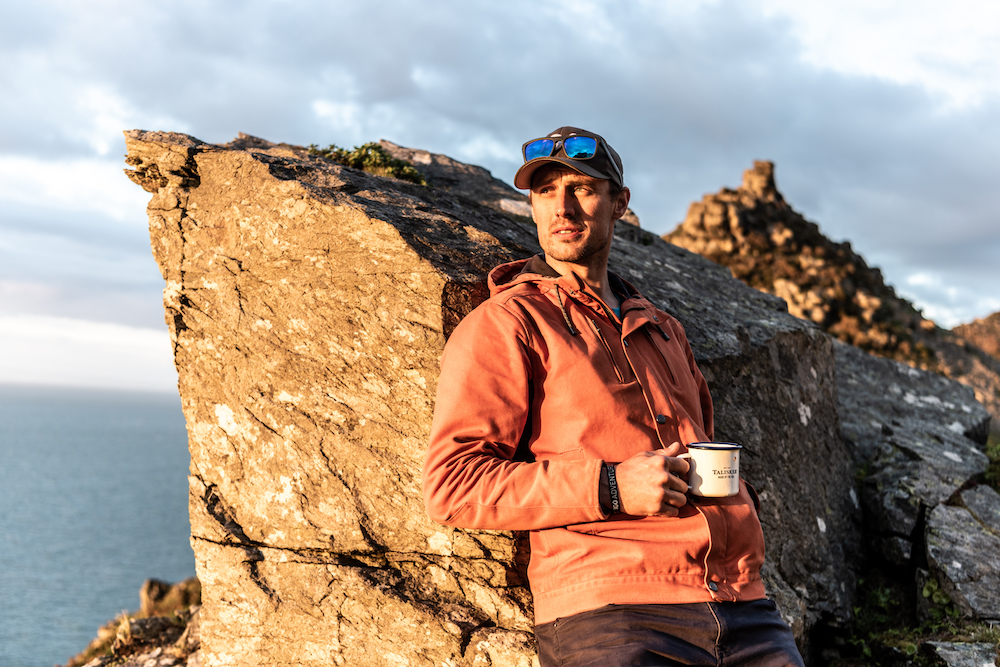
George, IGO Talisker
And I hope that as a population post-COVID 19, we would endeavour – and government as well – to embark on putting the planet’s climate back on track. That might lead me nicely into my next project. So my expedition this winter is called the Dark Ice Projects We are heading up on to the Arctic Ocean in the depths of winter together, never before seen content, imagery and data.
So we’ll be getting a boat locked into the ice at the end of summer, letting the ice form around us and from that boat being able to conduct a series, gather a series of scientific data, which we can then send back live from the middle of the Arctic Ocean in the depths of it.
As most of you know, the Arctic Ocean is a pivotal barometer to the health of our entire planet. It acts like a freezer, like the earth’s cooler. So as soon as we lose the thin layer of ice that forms a crust over the Arctic Ocean, we then enter a negative feedback loop of ocean warming as the sun’s rays consistently now warm the ocean, the Arctic Ocean beneath it. The ice will not have a chance of coming back.
So the fact that we don’t know very much about the Arctic Ocean in winter is extremely concerning for me. And I am hopeful that as this expedition starts to come out a little more over the coming weeks and months, it will also concern other people and give them a reason to follow and engage with this project. We are heading up onto the Arctic Ocean this winter to gather never-seen-before content, imagery, data research for leading scientists and universities all over the globe with a view – or with a hope -–that it will allow governments, corporates and individuals to make more informed and better decisions around how to protect our planet, and in particular the precious ice on the Arctic Ocean.
Peter George Bullard, it’s been a pleasure talking to and we wish you the very best of luck with Dark Ice, your next expedition this winter to the Arctic Ocean.
George Thank you for having me. It’s an absolute pleasure.
Felice That’s all for now. If you’ve enjoyed the show, please share this episode with at least one other person! Do also subscribe on Spotify, i-Tunes, Stitcher, or any of the many podcast providers – where you can give us a rating. You can also find us on Twitter, Facebook and Instagram. Stay safe and we’ll see you next week.
For more information on George, visit his website georgebullard.co.uk and also see IGO Adventures.
© Action Packed Travel

- Join over a hundred thousand podcasters already using Buzzsprout to get their message out to the world.
- Following the link lets Buzzsprout know we sent you, gets you a $20 Amazon gift card if you sign up for a paid plan, and helps support our show.
